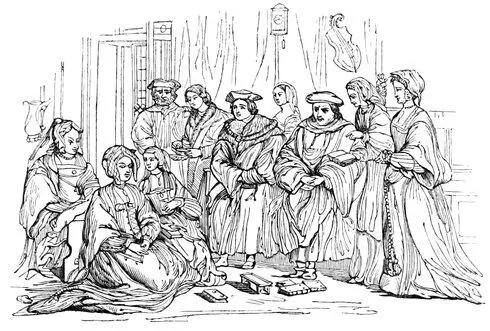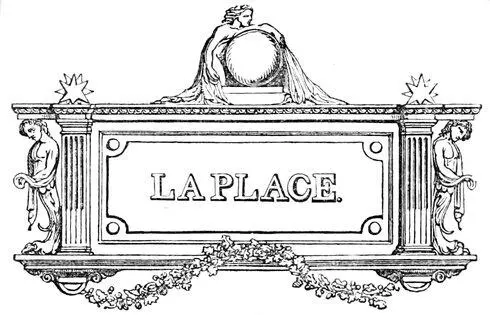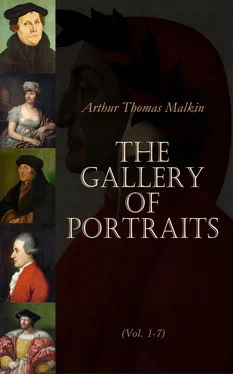His life has been written by his son-in-law, Roper, and is the principal source whence this narrative is taken. Erasmus has also been consulted, through whose epistolary works there is much information about his friend. There is also a life of him by Ferdinando Warner, LL.D., with a translation of his Utopia, in an octavo volume, published in 1758.


Engraved by J. Posselwhite. LA PLACE. From an original Picture by Nedeone, in the possession of the Marchioness De la Place. Under the Superintendance of the Society for the Diffusion of Useful Knowledge. London, Published by Charles Knight, Pall Mall East.

Table of Contents
Pierre Simon Laplace was born at Beaumont en Auge, a small town of Normandy, not far from Honfleur, in March, 1749. His father was a small farmer of sufficient substance to give him the benefit of a learned education, for we are told [4]that the future philosopher gained his first distinctions in theology. It does not appear by what means his attention was turned to mathematical science, but he must have commenced that study when very young, as, on visiting Paris at the age of about eighteen, he attracted the notice of D’Alembert by his knowledge of the subject. He had previously taught mathematics in his native place; and, on visiting the metropolis, was furnished with letters of recommendation to several of the most distinguished men of the day. Finding, however, that D’Alembert took no notice of him on this account, he wrote that geometer a letter on the first principles of mechanics, which produced an immediate effect. D’Alembert sent for him the same day, and said, “You see, sir, how little I care for introductions, but you have no need of any. You have a better way of making yourself known, and you have a right to my assistance.” Through the recommendation of D’Alembert, Laplace was in a few days named Professor of Mathematics in the Military School of Paris. From this moment he applied himself to the one great object of his life. It was not till the year 1799 that he was called to assume a public character. Bonaparte, then First Consul, who was himself a tolerable mathematician, and always cultivated the friendship of men of science, made him Minister of the Interior; but very soon found his mistake in supposing that talents for philosophical investigation were necessarily accompanied by those of a statesman. He is reported to have expressed himself of Laplace in the following way:—“Géometre du premier rang, il ne tarda pas a se montrer administrateur plus que médiocre. Dés son premier travail, les consuls s’aperçurent qu’ils s’étoient trompés. Laplace ne saisissait aucune question sous son vrai point de vue. Il cherchait des subtilités partout, n’avait que des idées problématiques et portait aufin l’esprit des infiniments petits dans l’administration.” Bonaparte removed him accordingly to the Sénat Conservateur , of which he was successively Vice-President and Chancellor. The latter office he received in 1813, about which time he was created Count. In 1814 he voted for the deposition of Napoleon, for which he has been charged with ingratitude and meanness. This is yet a party question; and the present generation need not be hasty in forming a decision which posterity may see reason to reverse. After the first restoration Laplace received the title of Marquis, and did not appear at the Court of Napoleon during the hundred days. He continued his usual pursuits until the year 1827, when he was seized with the disorder which terminated his life on the 5th of May, in the seventy-eighth year of his age. His last words were, “Ce que nous connoissons est peu de chose; ce que nous ignorons est immense.” He has left a successor to his name and title, but none to his transcendent powers of investigation.
The name of Laplace is spread to the utmost limits of civilization, as the successor, almost the equal, of Newton. No one, however, who is acquainted with the discoveries of the two, will think there is so much common ground for comparison as is generally supposed. Those of Laplace are all essentially mathematical: whatever could be done by analysis he was sure to achieve. The labours of Newton, on the other hand, show a sagacity in conjecturing which would almost lead us to think that he laid the mathematics on one side, and used some faculty of perception denied to other men, to deduce these results which he afterwards condescended to put into a geometrical form, for the information of more common minds. In the Principia of Newton, the mathematics are not the instruments of discovery but of demonstration; and, though that work contains much which is new in a mathematical point of view, its principal merit is of quite another character. The mind of Laplace was cast in a different mould; and this perhaps is fortunate for science, for while we may safely assert that Laplace would never have been Newton had he been placed in similar circumstances, there is also reason to doubt whether a second Newton would have been better qualified to follow that particular path which was so successfully traversed by Laplace. We shall proceed to give such an idea of the labours of the latter as our limits will allow.
The solution of every mechanical problem, in which the acting forces were known, as in the motions of the solar system, had been reduced by D’Alembert and Lagrange to such a state that the difficulties were only mathematical; that is, no farther advances could be made, except in pure analysis. We cannot expect the general reader to know what is meant by the words, solution of a Differential Equation ; but he may be made aware that there is a process so called, which, if it could be successfully and exactly performed in all cases, would give the key to every motion of the solar system, and render the determination of its present, and the prediction of its future state, a matter of mathematical certainty. Unfortunately, in the present state of analysis, such precision is unattainable; and its place is supplied by slow and tedious approximations. These were begun by Newton, whose object being to establish the existence of universal gravitation, he was content to show that all the phenomena which might be expected to result, if that theory were true, did actually take place in the solar system. But here, owing to the comparatively imperfect state of mathematical analysis, he could do little more than indicate the cause of some of the principal irregularities of that system. His successors added considerably to the number of phenomena which were capable of explanation, and thereby increased the probability of the hypothesis. Lagrange, the great rival of Laplace, if we consider his discoveries, and his superior in the originality of his views, and the beauty of his analysis, added greatly to the fund; but it was reserved for the latter to complete the system, and, extending his views beyond the point to which Newton directed his attention, to show that there is no marked phenomenon yet observed by astronomers, regarding the relative motions of the planets or their satellites, but what must necessarily follow, if the law of gravitation be true. We shall select a few instances of the success of his analysis. The average motions of Jupiter and Saturn had been observed to vary; that of the former being accelerated, and of the latter retarded. This fact, which Euler had attempted in vain to explain, was linked by Laplace to the general law, and shown to follow from it. A somewhat similar acceleration in the moon’s mean motion was demonstrated, as we have observed more fully in the life of Halley, to arise from a small alteration in the form of the earth’s orbit, caused by the attraction of the planets. A remarkable law attending the motions of the satellites of Jupiter, viz.—that the mean motion of the first satellite, together with double that of the second, is always very nearly equal to three times that of the third—was so far connected with the general law, that if, in the original formation of the system, that relation had been nearly kept, the mutual attractions, instead of altering it, would tend to bring it nearer the truth. We can here do no more than mention the analysis of the phenomena of the tides, one of the most important and most brilliant of Laplace’s performances. Indeed there is no branch of Physical Astronomy, we might almost say of physics in general, which is not materially indebted to him. Superior to Euler in the power of conquering analytical difficulties, he is almost his equal in the universality of his labours.
Читать дальше















